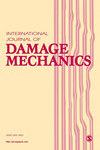Effect of microstructural damage evolution on tensile strength of ultra-high performance concrete: A multiscale numerical scheme
IF 3.9
2区 工程技术
Q2 MATERIALS SCIENCE, MULTIDISCIPLINARY
引用次数: 0
Abstract
This study aims to investigate the tensile behavior of ultra-high performance concrete (UHPC) using a multiscale modeling approach. A micromechanics-based finite-element method is employed to investigate the evolution of microstructural damage and its effect on the macroscopic tensile strength of UHPC. X-ray computed tomography (CT) techniques are used to create a realistic microstructural geometry, and the cohesive-zone models are adopted to quantify the microcrack growth rate and the overall mechanical properties of UHPC under tension. A stiffness-degradation parameter is introduced to explain the evolution of the material tensile behavior. Satisfactory agreements are achieved between the simulation results and the experimental data from the direct tensile tests. To demonstrate the capability of the proposed multiscale modeling framework, the influences of curing age and freeze–thaw cycles of UHPC materials are further taken into account. The proposed multiscale simulation scheme integrated with the x-ray CT techniques and cohesive-zone model can serve as an effective and reliable method to capture the nonlinear tensile responses of UHPC materials and structures.微结构损伤演化对超高性能混凝土抗拉强度的影响:一种多尺度数值格式
本研究旨在采用多尺度建模方法研究超高性能混凝土(UHPC)的拉伸行为。研究采用了基于微观力学的有限元方法来研究微观结构损伤的演变及其对超高强混凝土宏观抗拉强度的影响。利用 X 射线计算机断层扫描(CT)技术创建了逼真的微观结构几何形状,并采用内聚区模型来量化微裂纹的增长速度和拉伸条件下超高强度混凝土的整体力学性能。引入了刚度降解参数来解释材料拉伸行为的演变。模拟结果与直接拉伸试验的实验数据之间达到了令人满意的一致。为了证明所提出的多尺度建模框架的能力,还进一步考虑了 UHPC 材料的固化龄期和冻融循环的影响。所提出的多尺度模拟方案与 X 射线 CT 技术和内聚区模型相结合,可作为捕捉 UHPC 材料和结构非线性拉伸响应的有效而可靠的方法。
本文章由计算机程序翻译,如有差异,请以英文原文为准。
求助全文
约1分钟内获得全文
求助全文
来源期刊

International Journal of Damage Mechanics
工程技术-材料科学:综合
CiteScore
8.70
自引率
26.20%
发文量
48
审稿时长
5.4 months
期刊介绍:
Featuring original, peer-reviewed papers by leading specialists from around the world, the International Journal of Damage Mechanics covers new developments in the science and engineering of fracture and damage mechanics.
Devoted to the prompt publication of original papers reporting the results of experimental or theoretical work on any aspect of research in the mechanics of fracture and damage assessment, the journal provides an effective mechanism to disseminate information not only within the research community but also between the reseach laboratory and industrial design department.
The journal also promotes and contributes to development of the concept of damage mechanics. This journal is a member of the Committee on Publication Ethics (COPE).
 求助内容:
求助内容: 应助结果提醒方式:
应助结果提醒方式:


